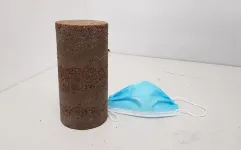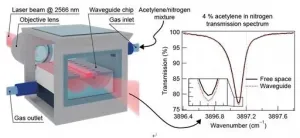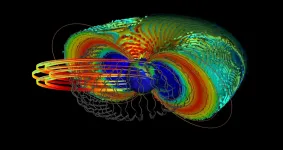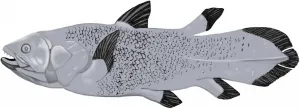(Press-News.org) Researchers have shown how disposable face masks could be recycled to make roads, in a circular economy solution to pandemic-generated waste.
Their study shows that using the recycled face mask material to make just one kilometre of a two-lane road would use up about 3 million masks, preventing 93 tonnes of waste from going to landfill.
Developed by researchers at RMIT University in Melbourne, Australia, the new road-making material is a mix of shredded single-use face masks and processed building rubble designed to meet civil engineering safety standards.
Analysis shows the face masks help to add stiffness and strength to the final product, designed to be used for base layers of roads and pavements.
The study published in the journal Science of the Total Environment is the first to investigate potential civil construction applications of disposable surgical face masks.
The use of personal protective equipment (PPE) has increased dramatically during the COVID-19 pandemic, with an estimated 6.8 billion disposable face masks being used across the globe each day.
First author Dr Mohammad Saberian said multidisciplinary and collaborative approaches were now needed to tackle the environmental impact of COVID-19, particularly the risks associated with the disposal of used PPE.
"This initial study looked at the feasibility of recycling single-use face masks into roads and we were thrilled to find it not only works, but also delivers real engineering benefits," Saberian said.
"We hope this opens the door for further research, to work through ways of managing health and safety risks at scale and investigate whether other types of PPE would also be suitable for recycling."
Making roads with masks
Roads are made of four layers: subgrade, base, sub-base and asphalt on top. All the layers must be both strong and flexible to withstand the pressures of heavy vehicles and prevent cracking.
Processed building rubble - known as recycled concrete aggregate (RCA) - can potentially be used on its own for the three base layers.
But the researchers found adding shredded face masks to RCA enhances the material while simultaneously addressing environmental challenges on two fronts: PPE disposal and construction waste.
Construction, renovation and demolition account for about half the waste produced annually worldwide, and in Australia, about 3.15 million tons of RCA is added to stockpiles each year rather than being reused.
The study identified an optimal mixture - 1% shredded face masks to 99% RCA - that delivers on strength while maintaining good cohesion between the two materials.
The mixture performs well when tested for stress, acid and water resistance, as well as strength, deformation and dynamic properties, meeting all the relevant civil engineering specifications.
While the experimental study was conducted with a small amount of unused surgical face masks, other research has investigated effective methods for disinfecting and sterilising used masks.
A comprehensive review of disinfection technologies found 99.9% of viruses could be killed with the simple "microwave method", where masks are sprayed with an antiseptic solution then microwaved for one minute.
In related work, the RMIT researchers have also investigated the use of shredded disposable face masks as an aggregate material for making concrete, with promising preliminary findings.
Professor Jie Li leads the RMIT School of Engineering research team, which focuses on recycling and reusing waste materials for civil construction.
Li said the team was inspired to look at the feasibility of blending face masks into construction materials after seeing so many discarded masks littering their local streets.
"We know that even if these masks are disposed of properly, they will go to landfill or they'll be incinerated," he said.
"The COVID-19 pandemic has not only created a global health and economic crisis but has also had dramatic effects on the environment.
"If we can bring circular economy thinking to this massive waste problem, we can develop the smart and sustainable solutions we need."
INFORMATION:
'Repurposing of COVID-19 single-use face masks for pavements base/subbase', with co-authors RMIT Indigenous Pre-Doctoral Research Fellow Shannon Kilmartin-Lynch and Research Assistant Mahdi Boroujeni, is published in Science of the Total Environment (DOI: 10.1016/j.scitotenv.2021.145527).
Researchers from Peter the Great St.Petersburg Polytechnic University (SPbPU) in collaboration with colleagues from Belgium take a step in the development of genome editing technology. Currently it is possible to deliver genetic material of different sizes and structures to organs and tissues. This is the key to eliminating DNA defects and treating more patients. The project is guided by Professor Gleb Sukhorukov and supported by the Russian Science Foundation. Research results were published in Particle & Particle Systems Characterization journal.
An international research group developed a polymer ...
Semiconducting 2D alloys could be key to overcoming the technical limitations of modern electronics. Although 2D Si-Ge alloys would have interesting properties for this purpose, they were only predicted theoretically. Now, scientists from Japan Advanced Institute of Science and Technology have realized the first experimental demonstration. They have also shown that the Si to Ge ratio can be adjusted to fine tune the electronic properties of the alloys, paving the way for novel applications.
Alloys--materials composed of a combination of different elements or compounds--have played a crucial role in the technological development of humans since the Bronze Age. Today, ...
The Bronze Age (2200 to 800 BC) marked a decisive step in the technological and economic development of ancient societies. People living at the time faced a series of challenges: changes in the climate, the opening up of trade and a degree of population growth. How did they respond to changes in their diet, especially in Western Switzerland? A team from the University of Geneva (UNIGE), Switzerland, and Pompeu Fabra University (UPF) in Spain has for the first time carried out isotopic analyses on human and animal skeletons together with plant remains. The scientists discovered that manure use had become widespread over time to improve crop harvests in response to demographic growth. The researchers also found that there had ...
Optical waveguides suspended in air are capable to beat free-space laser beams in light-analyte interaction even without complex dispersion engineering. This phenomenon has been predicted more than 20 years ago, yet never observed in experiment.
In a new paper published in Light Science & Application, a team of scientists, led by Professor Jana Jágerská from Department of Science and Technology, UiT The Arctic University of Norway, and co-workers have devised a mid-infrared free standing solid core optical waveguide which pushes the light interaction with the surrounding air beyond what has been reported up until now: 107 % interaction strength compared to that of a free-space beam has been demonstrated.
"The guided mode of our thin waveguide ...
New study found that electrons can reach ultra-relativistic energies for very special conditions in the magnetosphere when space is devoid of plasma.
Recent measurements from NASA's Van Allen Probes spacecraft showed that electrons can reach ultra-relativistic energies flying at almost the speed of light. Hayley Allison, Yuri Shprits and collaborators from the German Research Centre for Geosciences have revealed under which conditions such strong accelerations occur. They had already demonstrated in 2020 that during solar storm plasma waves play a crucial role for that. However, it was previously unclear why such high electron energies are not achieved ...
The COVID-19 pandemic has upended many parts of daily life, one of them being our work life. Research carried out by the Universitat Oberta de Catalunya (UOC) has studied the factors that help make efficient work teams. The explanation is multidimensional and multilevel.
"Inspiring leadership builds employees' resilience and willingness to undertake new challenges," said Pilar Ficapal Cusi, professor at the UOC's Faculty of Economics and Business and one of the authors of the study, which was published in the Journal of Cleaner Production.
Viewed from the group and organizational perspective, "the shared vision, the team's belief in its own creative effectiveness, the ability to reflect openly about how their members connect to adapt ...
Researchers at Lund University in Sweden have discovered the individual traits of fungi, and how their hyphae - that is, the fungal threads that grow in soil - behave very differently as they navigate through the earth's microscopic labyrinths.
The study was performed in a lab environment, and the underground system constructed synthetically from silicone. Using a microscope, researchers were able to follow seven species and compare their behaviour. How do they react when the maze they grow in turns sharply and forces the hyphae to grow in the direction it came from? What happens when a large space opens up in front of them?
"Under a microscope, their behaviour becomes much more personal than you can ever imagine. ...
Parasitic worms could hold the key to living longer and free of chronic disease, according to a review article published today in the open-access eLife journal.
The review looks at the growing evidence to suggest that losing our 'old friend' helminth parasites, which used to live relatively harmlessly in our bodies, can cause ageing-associated inflammation. It raises the possibility that carefully controlled, restorative helminth treatments could prevent ageing and protect against diseases such as heart disease and dementia.
"A decline in exposure to commensal microbes and gut helminths in developed countries ...
A greater exposure to air pollution at the very start of life was associated with a detrimental effect on people's cognitive skills up to 60 years later, the research found.
Researchers at the University of Edinburgh tested the general intelligence of more than 500 people aged approximately 70 years using a test they had all completed at the age of 11 years.
The participants then repeated the same test at the ages of 76 and 79 years.
A record of where each person had lived throughout their life was used to estimate the level of air pollution they had experienced in their early years.
The team used statistical models to analyse the relationship between a person's exposure to air pollution ...
To evaluate the chemical composition of food from a physiological point of view, it is important to know the functions of the receptors that interact with food ingredients. These include receptors for bitter compounds, which first evolved during evolution in bony fishes such as the coelacanth. What 400 million years of evolutionary history reveal about the function of both fish and human bitter receptors was recently published in the journal Genome Biology and Evolution by a team of researchers led by the Leibniz Institute for Food Systems Biology at the Technical University of Munich and the University of Cologne.
Evolutionarily, bitter receptors are a relatively recent invention of nature compared ...




